八种时态常用的标志词
八大时态的标志词

盛淼
1、一般将来时 2、一般现 在时 3、现在进行时 4、现在完成时 5、一般 过去时 6、过去进行时 7、过去完成时 8、过去 将来时
一般将来时
(1)tomorrow, the day after tomorrow, tomorrow morning (evening, afternoon)
(2)for + 一段时间, since + 过去某一 点时间
过去完成时
1.by,by the time (of),by the end of,+过去时间
2when.before.after…….+过去时 间
现在进行时
1.now.Look.Listen.
2.What is he doing? He is watching Tv.
(2)every day, every morning, every Saturday, every time
(3)in the morning, on Saturdays
(4)once a week, three times, a day, twice a year
现在完成时
(1)already, yet, ever, never, just, before
过去进行时
1.at that time.at that moment.this time yesterday evening
ห้องสมุดไป่ตู้
1一般将来时2一般现3现在进行时4现在完成时5一般过去时6过去进行时7过去完成时8过去将来时一般将来时11tomorrowtomorrowdaydayafteraftertomorrowtomorrowowmorningmorningeveningeveningafternoonafternoon2nexttimenextfridaynexttermnextmonth33in22hourshoursaaweekweek33years?years?timetimeaaminuteminutemonentmonentrightawayonce一般过去时一般过去时daybeforeyesterdayyesterdaymorningeveningafternoon22lastlasttimetimelastlastfridayfridaylastlasttermtermlastlastmonthmonthhoursagoweekagoyearsago4justnowmomentago4justnowmomentago一般现在时11alwaysalwaysusuallyusuallyoftenoftensometimessometimes2everydayeverymorningeverysaturdayeverytime33inmorningmorningsaturdayssaturdays104onceweekthreetimesdaytwiceyear现在完成时现在完成时111alreadyyeteverneverjustbefore一段时间一段时间since过去某一过去某一点时间点时间12过去完成时1bybyendof过去时间过去时间132whenbeforeafter
关于时态的标志词

关于时态的标志词时态是英语语法的重要部分,它描述动作和状态发生的时间。
在使用时态时,我们可以通过一些标志词来帮助我们判断应该使用哪种时态。
下面是针对不同时态的标志词列表,希望对你的英语写作能够有所帮助。
一、一般现在时:1. Always2. Usually3. Often4. Sometimes5. Seldom6. Rarely7. Never8. Every day/week/month/year9. On Mondays/Tuesdays/etc.10. In the morning/afternoon/evening二、进行时:1. Right now2. At the moment3. Currently4. Today5. Tonight6. This week/month/year7. At this time8. Nowadays三、一般过去时:1. Yesterday2. Last week/month/year3. In 1999/2002/etc.4. When I was a child5. At that time6. In the past四、过去进行时:1. At 8:00 last night2. At this time yesterday3. While I was walking4. During the party last night五、将来时:1. Tomorrow2. Next week/month/year3. In five years4. Soon5. Later6. At some point in the future7. In the near/distant future六、将来进行时:1. At 10:00 tonight2. Next week at this time3. In two years' time4. In the future七、现在完成时:1. Already2. Yet3. Just4. In the past few days/weeks/months/years5. So far6. Since I arrived/started/etc.7. For a long/short time八、过去完成时:1. Before2. By the time3. After4. When5. Already6. Just7. Had not...yet九、情态动词:1. Can2. Could3. May4. Might5. Must6. Shall7. Should8. Will9. Would。
八大时态标志词
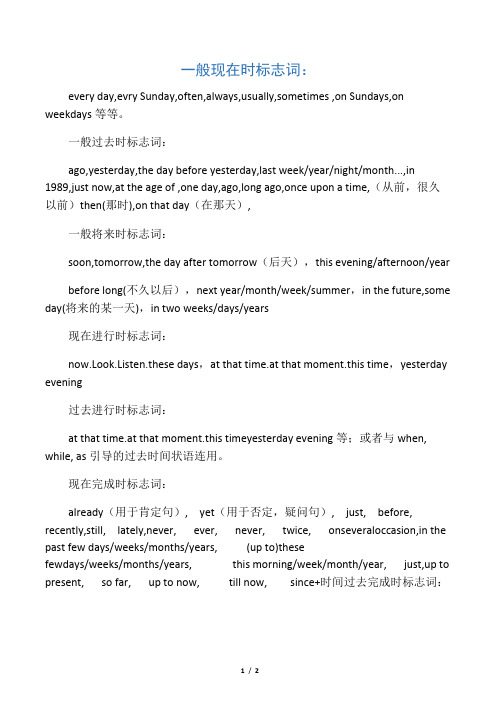
一般现在时标志词:every day,evry Sunday,often,always,usually,sometimes ,on Sundays,on weekdays等等。
一般过去时标志词:ago,yesterday,the day before yesterday,last week/year/night/month (i)1989,just now,at the age of ,one day,ago,long ago,once upon a time,(从前,很久以前)then(那时),on that day(在那天),一般将来时标志词:soon,tomorrow,the day after tomorrow(后天),this evening/afternoon/yearbefore long(不久以后),next year/month/week/summer,in the future,some day(将来的某一天),in two weeks/days/years现在进行时标志词:now.Look.Listen.these days,at that time.at that moment.this time,yesterday evening过去进行时标志词:at that time.at that moment.this timeyesterday evening等;或者与when, while, as引导的过去时间状语连用。
现在完成时标志词:already(用于肯定句), yet(用于否定,疑问句), just, before, recently,still, lately,never, ever, never, twice, onseveraloccasion,in the past few days/weeks/months/years, (up to)thesefewdays/weeks/months/years, this morning/week/month/year, just,up to present, so far, up to now, till now, since+时间过去完成时标志词:by, by the time (of), by the end of +过去时间;when. before.after…….+过去时间;uptillthen(直到时);upuntillastnight(直到昨晚)等;already, just, ever, yet 等。
英语常见时态标志词语

1现在完成时的词语标志,遇到这样的词一般用完成时2一些其他时态的标志词语现为你提供如下八种时态常用的标志词。
1、一般现在时表示:现阶段经常发生的动作或存在的状态标志: often、usually、always、sometimes、every day、in the morning (afternoon …)、on Sundays, once a week等例子:We go to school at six forty every day.My brother reads a book once a week.2、一般将来时表示:将要发生的动作或存在的状态标志:tomorrow、next week、this month、in an hour、the day after tomorrow 等例子:He will go to see a doctor tomorrow.I am going to play basketball next week..She is coming back in an hour.3、一般过去时表示:过去发生的动作或存在的状态标志: yesterday、last week、three days ago、the day before yesterday, in 1990 等例子:I finished my work yesterday.He went to New York ten days ago.4、现在进行时表示:现在正在进行的动作标志:now、Look! Listen! It’s six o’clock..例子:Look! The boy is playing with a cat.It’s eight o’clock . The Smiths are watching TV in the living room.5、过去进行时表示:过去某个时刻正在进行的动作标志:at six yesterday morning、from 7 to 9 yesterday morning 、this time yesterday、也可用在when和while引导的从句例子: He was taking a shower at 11 last night .They were cooking when the bell rang.(= While they were cooking, the bell rang.)6、现在完成时结构: have / has + 动词过去分词(一般+ed , 特殊见不规则表)表示:1)表示过去发生或完成的某一动作对现在造成的影响或结果。
常用英语8种时态标志词

常用英语8种时态标志词英语时态是英语语法中一个非常重要的部分,正确地运用时态标志词能够帮助我们清晰地表达出过去、现在和将来的概念。
在英语中,有许多种时态标志词,其中有一些是比较常用且基础的。
下面就为大家介绍一下常用的8种英语时态标志词。
一、一般现在时一般现在时表示现在经常性或习惯性的动作或状态,常用的时态标志词有:always, usually, often, sometimes, seldom, never等。
二、一般过去时一般过去时表示在过去某个具体时间内发生的动作或存在的状态,常用的时态标志词有:yesterday, last week, a few days ago, in 1990等。
三、一般将来时一般将来时表示将来某个时间内会发生的动作或存在的状态,常用的时态标志词有:tomorrow, next week, in the future, soon等。
四、现在进行时现在进行时表示现在正在进行的动作,常用的时态标志词有:now, at the moment, currently, right now等。
五、过去进行时过去进行时表示过去某个时间内正在进行的动作,常用的时态标志词有:at that time, while, when等。
六、将来进行时将来进行时表示将来某个时间内将正在进行的动作,常用的时态标志词有:this time tomorrow, next Sunday, by this time等。
七、过去完成时过去完成时表示在过去某个时间之前已经完成的动作,常用的时态标志词有:before, by the time, already, just等。
八、将来完成时将来完成时表示在将来某个时间之前将已经完成的动作,常用的时态标志词有:by this time tomorrow, by the end of next month, in a year等。
总结来说,正确地运用这些时态标志词能够帮助我们清晰地表达不同时间内的动作或状态,增加文章的逻辑性和连贯性,是我们学习英语时态的重要组成部分。
英语八大时态标志词及结构表

英语八大时态标志词及结构表篇一:英语八大时态标志词及结构表英语中有多种时态,每种时态都有其特定的标志词和结构。
掌握这些时态标志词和结构可以帮助我们正确地运用不同的时态,表达出准确的时间和语义。
以下是英语中常用的八大时态标志词及其结构表:1. 一般现在时 (Simple Present Tense):标志词: always, usually, often, sometimes, seldom, rarely, never, every day/week/month/year,on Mondays/Tuesdays,in themorning/afternoon/evening。
结构: 主语 + 动词原形 (+ 其他补充信息)例句: I always brush my teeth before going to bed.我睡觉前总是刷牙。
2. 一般过去时 (Simple Past Tense):标志词: yesterday, last week/month/year, ago, in 1990, when I was young。
结构: 主语 + 动词过去式 (+ 其他补充信息)例句: She visited her grandparents last weekend.她上个周末去看望了她的祖父母。
3. 一般将来时 (Simple Future Tense):标志词: tomorrow, next week/month/year, in the future, I will (I'll)。
结构: 主语 + will + 动词原形 (+ 其他补充信息)例句: We will go shopping tomorrow.我们明天去购物。
4. 现在进行时 (Present Continuous Tense):标志词: now, at the moment, currently, right now, look!。
常用英语8种时态标志词

常用英语8种时态这64个标志词就够了一般现在时always,ususlly,often,sometimesnever ,seldom很少(否定词)every day/week/month/year/morning/evening/nighteach day/week/month/year/morning/evening/nightonce a week每周一次,twice a month每月两次,three times a year一年三次in the morning 早晨on Saturdays 周六every morning 每天早晨every Saturday 每个周六一般过去时yesterday昨天the day before yesterday前天,two days ago两天前last day/night/week/month/year 昨天/夜;上周/月;去年in 1990 在1990年just now刚才at the age of five五岁时once upon a time 从前in the past 过去a moment ago 刚刚long long ago 很久以前in 1988 1988年last Friday 上周五一般将来时tomorrow 明天the day after tomorrow 后天tomorrow morning 明天早上next time 下次next Friday/term/month/yearin+一段时间soon/right awayin the future现在进行时now 现在look 看listen 听at this time/moment此时these days 这些天at present 现在现在完成时already/yetjustnevereverfor+一段时间since+时间一点so far/up to now 到目前为止in the past three years 在过去3年里过去完成时by+过去时间点by the timeby thenby the end of last yearbefore+过去时间点up till+过去时间点up till then过去进行时at that timeat that momentyesterday evening过去将来时the following monththe next timethe next fridaythe next term。
六年级英语【八大时态标志词】单词汇总
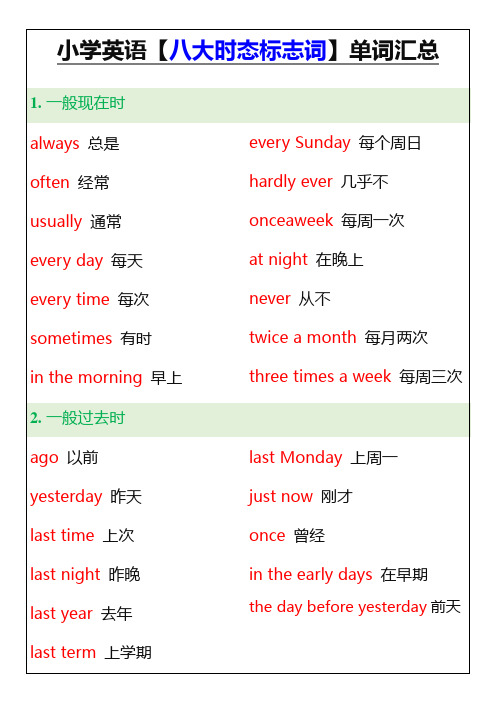
already已经
yet还
just刚才
never从不
ever曾经
before以前
uptonow目前为止
sofห้องสมุดไป่ตู้r目前为止
recently最近
since+过去某一时间
twice两次
tillnow迄今为止
uptonow到目前为止
5.现在进行时
now现在
look看
listen听
atthistime此时
twiceamonth每月两次
threetimesaweek每周三次
2.一般过去时
ago以前
yesterday昨天
lasttime上次
lastnight昨晚
lastyear去年
lastterm上学期
lastMonday上周一
justnow刚才
once曾经
intheearlydays在早期
thedaybeforeyesterday前天
(2)before+过去时间点before8:00
(3)upuntil+过去时间点upuntilthen直到那时
6.过去进行时
atthattime在那时
atthatmoment在那时
thewholemorning整个早上
7.将来进行时
tomorrow明天
soon不久
nextweek下周
thedayaftertomorrow后天
8.过去完成时
(1)by+过去时间点bythetime到..时候为止
bythen到那时候bylasttime最后一次
3.一般将来时
tomorrow明天
八种时态常用的标志词

四种时态常用的标志词1、一般现在时表示:现阶段经常发生的动作或存在的状态标志: often、usually、always、sometimes、everyday、in the morning/afternoon…、on Sundays, once a week.:We go to school at six forty every day.My brother reads a book once a week.注意变三单.....2、一般将来时表示:将要发生的动作或存在的状态标志:tomorrow、next week、this month、in an hour、the day after tomorrow.:He will go to see a doctor tomorrow.I am going to play basketball next week.She is coming back in an hour.3、一般过去时表示:过去发生的动作或存在的状态标志: yesterday、last week、three days ago、the day before yesterday, in 1990 finally just now .:I finished my work yesterday.He went to New York ten days ago.4、现在进行时表示:现在正在进行的动作标志:now、Look、Listen 、It is six o’clock.根据语境.:Look The boy is playing with a cat.It’s eight o’clock. The Smiths are watching TV in the living room.注情态动词后用动词原形..........形容词、动词;名词、副词互相转换。
常见八种时态标志词课件

现在进行时
现在进行时表示正在进行的动作 或存在的状态。
现在进行时的标志词包括“正在 ”、“正在”、“正在”、“正
在”等。
现在进行时可以用于描述正在发 生的事情、描述正在进行的动作
、表达正在存在的状态等。
现在完成时
现在完成时表示过去发生的动作 或状态对现在造成的影响或结果
。
现在完成时的标志词包括“已经 ”、“了”、“过”、“完成”
示例
By next year, we will have been studying English for three years.(到明年 ,我们将已经学了三年英语。)
将来完成进行时的用法
表示在将来某一时间之前已经开始的动作,并持续到将来某一时间。
表示在将来某一时间之前已经完成的动作,并对将来产生某种结果或影 响。
用法二
表示在过去的某个时间点之前,已经计划或安排好的事情,实际上 已经完成并进行了一段时间。
用法三
表示在过去的某个时间点,预计将会完成并进行一段时间的事情, 但实际上这个计划或安排被中断了。
THANKS FOR WATCHING
感谢您的观看
例句
Before I arrived, the meeting had already begun.
03
将来时态
将来时态概述
定义
表示将来某个时间将要发生的动 作或存在的状态
构成
基本结构是“助动词will/shall + 动词原形”
用法
常与表示将来的时间状语连用,如 tomorrow, next week, in 2023等
时间点
通常指过去的某个时间点,如 昨天、上周、去年等。
构成
英语语法中的八种时态

1 一般现在时主语+ 系动词标志词有often,usually,always等要注意“单三”,即he she it2 现在进行时主语+be动词+动词-ing形式标志词有now,at this time3 一般过去时主语+动词过去式标志词有ago, yesterday, the day before yesterday, last week, just now等4 过去进行时主语+ was/were + doing 标志词有at that time等5 现在完成时主语+ have/has + done 标志词有recently, lately, since6 过去完成时主语+had + done 标志词有before, by the end of last year等7 一般将来时主语+ ①am/is/are/going to + do;②will/shall + do.;③be+doing标志词有tomorrow, next day(week, month, year…),soon等8 过去将来时主语+①was/were/going to + do;②would/should + do 标志词有the next day等时态是英语学习中一个至关重要的内容,广大初中学生在实际运用时,往往对时态总是倍感棘手,下面我们就归纳复习一下这几种时态。
一、一般现在时:概念:经常、反复发生的动作或行为及现在的某种状况。
时间状语:always, usually, often, sometimes, every week (day, year, month…), once a week, on Sundays, etc.基本结构:①be动词;②行为动词否定形式:①am/is/are+not;②此时态的谓语动词若为行为动词,则在其前加don't,如主语为第三人称单数,则用doesn't,同时还原行为动词。
(完整word版)八大时态标志词
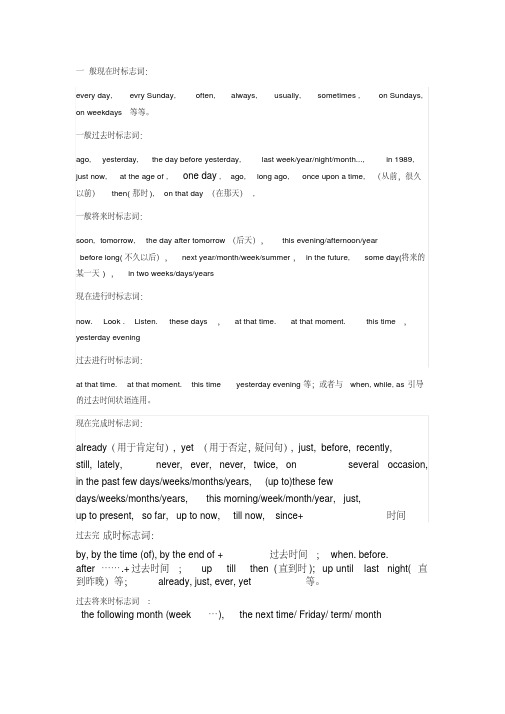
一般现在时标志词:every day, evry Sunday, often, always, usually, sometimes , on Sundays,on weekdays等等。
一般过去时标志词:ago, yesterday, the day before yesterday, last week/year/night/month..., in 1989,just now, at the age of , one day, ago, long ago, once upon a time,(从前,很久以前)then(那时), on that day(在那天),一般将来时标志词:soon, tomorrow, the day after tomorrow(后天),this evening/afternoon/yearbefore long(不久以后),next year/month/week/summer,in the future, some day(将来的某一天) ,in two weeks/days/years现在进行时标志词:now. Look. Listen. these days ,at that time. at that moment. this time ,yesterday evening过去进行时标志词:at that time. at that moment. this time yesterday evening等;或者与when, while, as引导的过去时间状语连用。
现在完成时标志词:already(用于肯定句), yet(用于否定,疑问句), just, before, recently,still, lately, never, ever, never, twice, on several occasion, in the past few days/weeks/months/years, (up to)these fewdays/weeks/months/years, this morning/week/month/year, just,up to present, so far, up to now, till now, since+时间过去完成时标志词:by, by the time (of), by the end of + 过去时间; when. before. after…….+过去时间; up till then (直到时); up until last night(直到昨晚)等; already, just, ever, yet 等。
初中英语八大时态基本结构与标志词
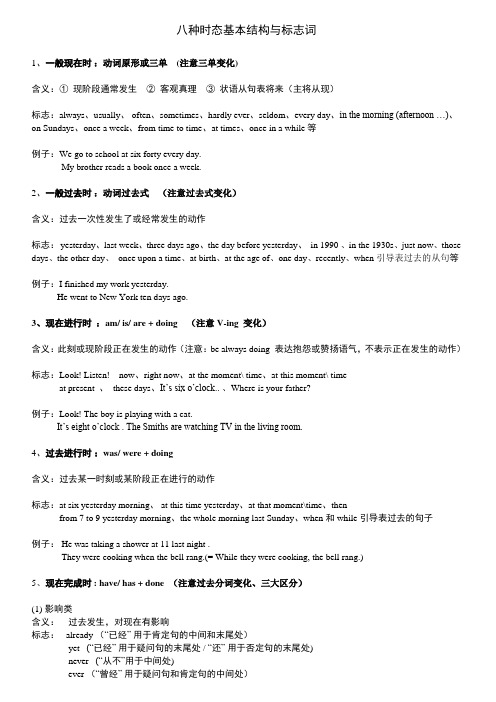
八种时态基本结构与标志词1、一般现在时:动词原形或三单(注意三单变化)含义:①现阶段通常发生②客观真理③状语从句表将来(主将从现)标志:always、usually、 often、sometimes、hardly ever、seldom、every day、in the morning (afternoon …)、on Sundays、once a week、from time to time、at times、once in a while等例子:We go to school at six forty every day.My brother reads a book once a week.2、一般过去时:动词过去式(注意过去式变化)含义:过去一次性发生了或经常发生的动作标志: yesterday、last week、three days ago、the day before yesterday、in 1990 、in the 1930s、just now、those days、the other day、once upon a time、at birth、at the age of、one day、recently、when引导表过去的从句等例子:I finished my work yesterday.He went to New York ten days ago.3、现在进行时:am/ is/ are + doing (注意V-ing 变化)含义:此刻或现阶段正在发生的动作(注意:be always doing 表达抱怨或赞扬语气,不表示正在发生的动作)标志:Look! Listen! now、right now、at the moment\ time、at this moment\ timeat present 、these days、It’s six o’clock..、Where is your father?例子:Look! The boy is playing with a cat.It’s eight o’clock . The Smiths are watching TV in the living room.4、过去进行时:was/ were + doing含义:过去某一时刻或某阶段正在进行的动作标志:at six yesterday morning、 at this time yesterday、at that moment\time、thenfrom 7 to 9 yesterday morning、the whole morning last Sunday、when和while引导表过去的句子例子: He was taking a shower at 11 last night .They were cooking when the bell rang.(= While they were cooking, the bell rang.)5、现在完成时 : have/ has + done (注意过去分词变化、三大区分)(1)影响类含义:过去发生,对现在有影响标志:already (“已经”用于肯定句的中间和末尾处)yet (“已经”用于疑问句的末尾处 / “还”用于否定句的末尾处)never (“从不”用于中间处)ever (“曾经”用于疑问句和肯定句的中间处)just (“刚刚”用于中间处)before ("之前" 用于句尾)once/ twice/ three times...例子:I have just cleaned my clothes. 我刚洗过衣服。
常见时态标志词

常见时态标志词常见的时态标志词包括:1. 一般现在时:do/does(被动:is/am/are done),常用于描述现阶段经常发生的动作或存在的状态,如“We go to school at six forty every day.”“My brother reads a book once a week.”2. 现在进行时:am/is/are+doing,常用于描述正在进行的动作,如“Look! He is running now.”3. 一般将来时:will do,常用于描述将要发生的动作或存在的状态,如“I will call you tomorrow.”4. 过去进行时:was/were+doing,常用于描述过去某个时刻正在进行的动作,如“He was playing basketball at 5:00 yesterday afternoon.”5. 现在完成时:have/has+done,常用于描述已经完成的动作或存在的状态,如“I have finished my homework.”6. 过去完成时:had+done,常用于描述过去的某个时刻之前已经完成的动作,如“By the end of last year, they had built many new houses.”7. 过去将来时:would do,常用于描述过去的某个时刻预测未来的动作或状态,如“He said he would go to New York next year.”8. 过去完成进行时:had been doing,常用于描述过去的某个时刻之前一直在进行的动作,如“They had been waiting for the bus for half an hour before it arrived.”这些时态标志词可以帮助我们更好地理解和使用英语中的时态,在不同的语境中表达准确的时间关系和动作状态。
时态的标志词

时态的标志词:时间状语。
1一般现在时:always/usually/often/sometimes/hardly ever/hardly/never every dayonce a week /twice a week 提问how oftenIn the morning/afternoon/e evening/ on Sundaysif till until unless when as soon as2一般过去时yesterday the day before yesterday =the other day前a few minutes agojust now 刚才last Sunday /last week this morning often/…+过去时间on Sunday on Monday3一般将来时tomorrow/ 明天the day after tomorrow后天next year 明年/ next Sunday in a few days /in two days(How soon)in the future 将来before long 不久= soon this evening 今晚by the end of this term4.过去将来said /told ------tomorrow/ the next week.5.现在进行时now = at the moment= at this time 就在现在at present 目前these days 这些天look, listen It’s six now6.过去进形时then =at the time 在那时this time yesterday昨天的这个时候from 7to eight last night at five yesterday昨天5点7.现在完成时1)just 刚刚already已经yet(问,否)还never 从不ever 疑问before以前rencetly最近2)twice /three times how many times ( have been to )3)for /since 过完since +从句+p.4)sofar 目前in the last few years 最近几年for years 数年8.过去完成时by that time 到那个时候by the end of last week 到上周末She said hHe told +3.现在进行时:am/is/are working 4过去进行时:was/were working5.一般将来时will/shall/is,am ,are going to work6.过去将来时:would work/was/were going to7.现在完成时has/have+worked 8过去完成时had worked现在进行完成时:has/have been workinghall/is,am ,are going to work过去进行时:was/were workingShall I/we… ? shall 只能与I/we 连用被动语态重点考:一般现在:am/is /are done一般过去:was/were done一般将来:will be+done1._____ you______ (clean) the room now? No, I____2._______ you ____(clean) the room every day.? Yes ,______3.I’m _________ (watch)4.Is Jim _______ (do) his homework? Yes,_____.5.Lilly and Lucy __________-(clean).now6.She ___________ (not read) now. She _________(do) her homework7.Loo k!They _________ (take)photos .8.Look !The cat _________(run) up the tree9.Listen!Who_________ (sing).10.Listen!The birds_________(sing)11.It’s six o’clock now We ________(have) dinner at home.12._____your father and mother _______(read)books/yes , ______13.Your friends ________(wait) for you.now.情态动词should /can / may / must +doneI. 句型转换1. The children had a good time in the park.否定句:__________________________________________一般疑问句:________________________________________对划线部分提问:____________________________________2. There were about nine hundred people at the concert.(音乐会) 否定句:__________________________________________一般疑问句:________________________________________ 对划线部分提问:____________________________________ 3. There was only one problem.否定句:__________________________________________ 一般疑问句:________________________________________ 肯定/否定回答:____________________________________ 4. Ann did her homework yesterday evening.否定句:__________________________________________ 一般疑问句:________________________________________ 对划线部分提问:____________________________________ 5. Last week I read an English book.否定句:__________________________________________ 一般疑问句:________________________________________ 肯定/否定回答:____________________________________ 对划线部分提问:____________________________________ 6. My brother was in the park just now.否定句:__________________________________________ 一般疑问句:________________________________________ 肯定/否定回答:____________________________________ 对划线部分提问:____________________________________7. She had some bread for lunch today.否定句:__________________________________________一般疑问句:________________________________________肯定/否定回答:____________________________________对划线部分提问:____________________________________8. They read English last night.否定句:__________________________________________一般疑问句:________________________________________肯定/否定回答:____________________________________对划线部分提问:____________________________________、写出下列动词的三单现、过去式和现在分词go ______ _______ _______ enjoy _______ _______ ________buy ______ ______ _______ eat______ _______ _______get _______ _______ _______ walk ________ _______ ________take______ ______ ______ dance_______ ________ _______write _______ ______ ______ run______ _______ _______swim_______ _______ _______ find _______ _______ _______begin______ ______ ______ eat ______ _______ ______play ______ ______ _______ study ______ ______ ________III. 用所给词的适当形式填空。
常见八种时态标志词
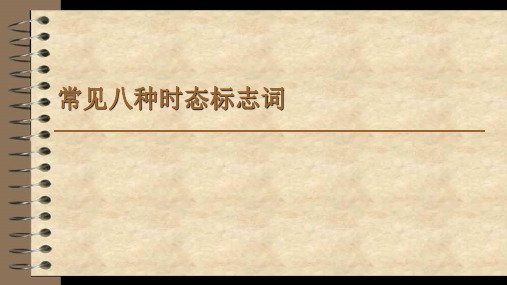
5.一般将来时用will do/be going to do. 标志词:tomorrow,tomorrow. morning,in the future, next week , next Sunday,in+一段时间, soon=right=at once很快,立刻.
6.过去将来时:would do 没有什么标志词,通常用在 从句里。
I didn't know if he would come.
7.现在完成时 has/have done 标志词:already, yet,ever曾经,never从未,just刚刚(与现
在有关的模糊过去时间),before,in the past 5 years, so far ,up to now, two times,for+时间段, since+时间点或从句 8.过去完成时 had done 标志词:by/by the end of+过去时间,by the year 2010....
2.现在进行时am/is /are+doing形式。 标志词:now,at this time, at present,句首有Look!,
Listen!Hurry!等警示语
3.一般过去时用动词的过去式did 标志词有:yesterday, last week , last month, last year, 时间段+ago,two years ago,in 1979,the day before yesterday,just now=a moment ago刚才(与现在无关的明 确过去动词原形do或第三人称单数does形式。
时态标志词
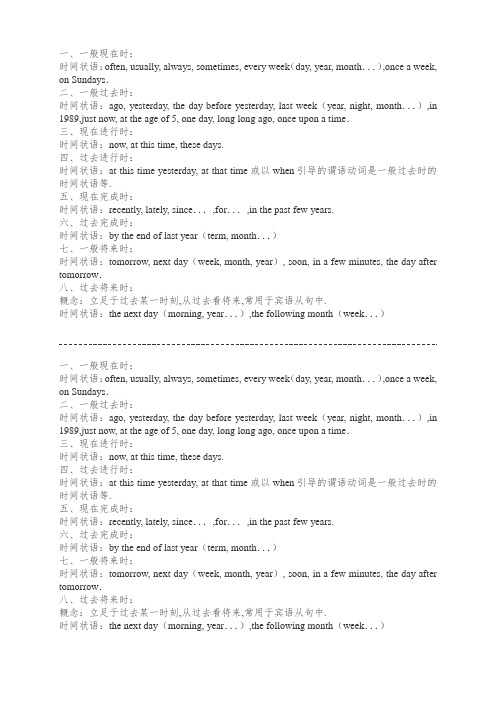
一、一般现在时:时间状语:often, usually, always, sometimes, every week(day, year, month...),once a week, on Sundays.二、一般过去时:时间状语:ago, yesterday, the day before yesterday, last week(year, night, month...),in 1989,just now, at the age of 5, one day, long long ago, once upon a time.三、现在进行时:时间状语:now, at this time, these days.四、过去进行时:时间状语:at this time yesterday, at that time或以when引导的谓语动词是一般过去时的时间状语等.五、现在完成时:时间状语:recently, lately, since...,for...,in the past few years.六、过去完成时:时间状语:by the end of last year(term, month...)七、一般将来时:时间状语:tomorrow, next day(week, month, year), soon, in a few minutes, the day after tomorrow.八、过去将来时:概念:立足于过去某一时刻,从过去看将来,常用于宾语从句中.时间状语:the next day(morning, year...),the following month(week...)一、一般现在时:时间状语:often, usually, always, sometimes, every week(day, year, month...),once a week, on Sundays.二、一般过去时:时间状语:ago, yesterday, the day before yesterday, last week(year, night, month...),in 1989,just now, at the age of 5, one day, long long ago, once upon a time.三、现在进行时:时间状语:now, at this time, these days.四、过去进行时:时间状语:at this time yesterday, at that time或以when引导的谓语动词是一般过去时的时间状语等.五、现在完成时:时间状语:recently, lately, since...,for...,in the past few years.六、过去完成时:时间状语:by the end of last year(term, month...)七、一般将来时:时间状语:tomorrow, next day(week, month, year), soon, in a few minutes, the day after tomorrow.八、过去将来时:概念:立足于过去某一时刻,从过去看将来,常用于宾语从句中.时间状语:the next day(morning, year...),the following month(week...)。
英语八大名词时态总结一览表
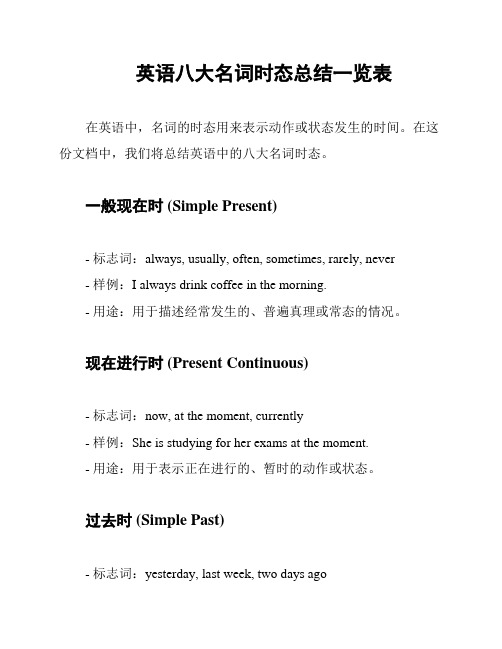
英语八大名词时态总结一览表在英语中,名词的时态用来表示动作或状态发生的时间。
在这份文档中,我们将总结英语中的八大名词时态。
一般现在时 (Simple Present)- 标志词:always, usually, often, sometimes, rarely, never- 样例:I always drink coffee in the morning.- 用途:用于描述经常发生的、普遍真理或常态的情况。
现在进行时 (Present Continuous)- 标志词:now, at the moment, currently- 样例:She is studying for her exams at the moment.- 用途:用于表示正在进行的、暂时的动作或状态。
过去时 (Simple Past)- 标志词:yesterday, last week, two days ago- 样例:We went to the beach yesterday.- 用途:用于表示过去发生的已经完成的动作或状态。
过去进行时 (Past Continuous)- 标志词:while, when, as- 样例:He was watching TV when I entered the room. - 用途:用于表示过去某一时刻正在进行的动作。
一般将来时 (Simple Future)- 标志词:will, going to- 样例:I will call you later.- 用途:用于表示将来发生的动作或状态。
将来进行时 (Future Continuous)- 标志词:while, by the time- 样例:She will be cooking dinner at 6 PM tomorrow. - 用途:用于表示将来某一时刻正在进行的动作。
现在完成时 (Present Perfect)- 标志词:already, yet, ever, never- 样例:I have already finished my homework.- 用途:用于表示过去发生的与现在有关的动作或状态,强调对现在的影响。
英语八大时态标志词及结构表

英语八大时态标志词及结构表篇一:英语八大时态标志词及结构表正文:英语中存在八大时态,分别是:过去时、现在时、将来时、过去将来时、现在进行时、将来进行时、过去进行时、现在完成时和未来完成时。
这些时态的不同表达方式和用法,对于英语写作和口语表达都是非常重要的。
本文将介绍这些时态的标志词和结构表,帮助学习者更好地理解和掌握这些时态。
1. 过去时过去时通常用“态”或“ed”表示,表示动作或状态发生在过去。
标志词包括:- was(过去分词):表示动作或状态发生在过去某个时间。
- are(过去分词):表示动作或状态发生在过去。
- was/are(过去分词):表示动作或状态发生在过去的某个时刻。
结构表:| 主语 | 谓语动词 | 时态标志词 || --- | --- | --- || I | I was | was/are || you | you are | are || he/she/it | he/she/it was | was/are || we | we are | are || they | they were | were/are |2. 现在时现在时通常用“态”或“ing”表示,表示动作或状态现在正在进行。
标志词包括:- am/is(现在分词):表示动作或状态现在正在进行。
- are(现在分词):表示动作或状态现在正在进行。
- was/are(现在分词):表示动作或状态现在正在进行。
结构表:| 主语 | 谓语动词 | 时态标志词 || --- | --- | --- || I | I am | am/is || you | you are | are || he/she/it | he/she/it is | is/are || we | we are | are || they | they are | are |3. 将来时将来时通常用“态”或“ing”表示,表示动作或状态将来会发生。
标志词包括:- will(将来分词):表示动作或状态将来会发生。
- 1、下载文档前请自行甄别文档内容的完整性,平台不提供额外的编辑、内容补充、找答案等附加服务。
- 2、"仅部分预览"的文档,不可在线预览部分如存在完整性等问题,可反馈申请退款(可完整预览的文档不适用该条件!)。
- 3、如文档侵犯您的权益,请联系客服反馈,我们会尽快为您处理(人工客服工作时间:9:00-18:30)。
八种时态常用的标志词
1、一般现在时
表示:现阶段经常发生的动作或存在的状态
标志: often、usually、always、sometimes、everyday、in the morning/afternoon…、on Sundays, once a week etc
e.g.:We go to school at six forty every day.
My brother reads a book once a week.
2、一般将来时
表示:将要发生的动作或存在的状态
标志:tomorrow、next week、this month、in an hour、the day after tomorrow etc
e.g.:He will go to see a doctor tomorrow.
I am going to play basketball next week.
She is coming back in an hour.
3、一般过去时
表示:过去发生的动作或存在的状态
标志: yesterday、last week、three days ago、the day before yesterday, in 1990 etc
e.g.:I finished my work yesterday.
He went to New York ten days ago.
4、现在进行时
表示:现在正在进行的动作
标志:now、Look!、Listen! 、It is six o’clock.
e.g.:Look! The boy is playing with a cat.
It’s eight o’clock. The Smiths are watching TV in the living room.
5、过去进行时
表示:过去某个时刻正在进行的动作
标志:at six yesterday morning、from 7 to 9 yesterday、this time yesterday、也可用在when 和while引导的从句
e.g.: He was taking a shower at 11 last night.
They were cooking when the bell rang. (= While they were cooking, the bell rang.)
6、现在完成时
结构: Have / has done
1)表示过去发生或完成的某一动作对现在造成的影响或结果。
标志: already (“已经”用于肯定句的中间和末尾处)、never (“从不”用于中间处) 、ever (“曾经”用于疑问句和肯定句的中间处)、just (“刚刚”用于中间处) 、yet (“已经”用于疑问句的末尾处/“还”用于否定句的末尾处)
e.g.: I have just cleaned my clothes. 我刚洗过衣服。
(“洗衣服”是发生在过去的动作,对现在造成的结果是“衣服干净了”)
2)表示从过去一直持续到现在的动作,将来还可能继续下去。
标志:for+时间段,如for three days
since+时间点/过去时从句,如since 1998,since she left here
e.g.:she has lived in Fuzhou for three years. / Since three years ago.
7、过去完成时
以过去某个时间为标准,在此以前发生的动作或行为,或在过去某动作之前完成的行为,即“过去的过去”。
标志:before, by the end of last year(term, month…) etc.
e.g.:The class had already begun when I came to school.
8、过去将来时
表示:从过去某个时间看将来发生的动作通常在宾语从句中出现,主句为过去时
e.g.: He said (that) he would visit the Great Wall the next day.
She told me (that) she was moving to France in two days.。
